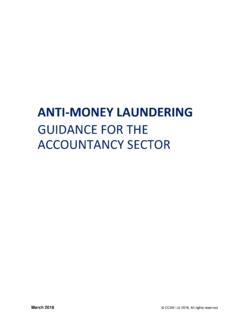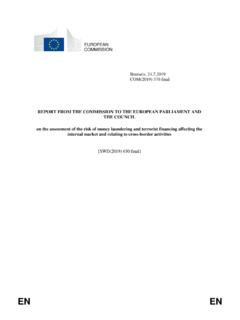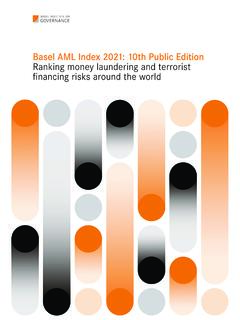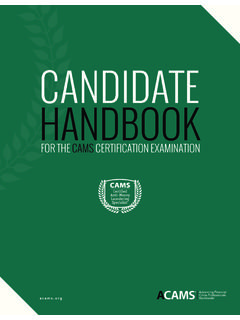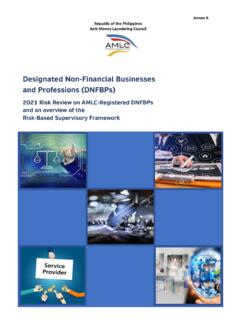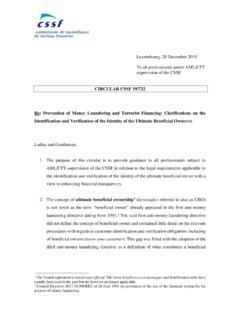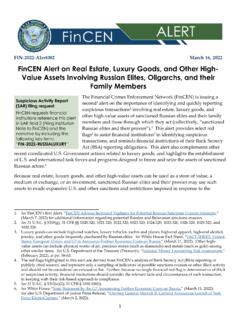Transcription of National risk assessment of money laundering and terrorist ...
1 National risk assessment of money laundering and terrorist financing 2020 December 2020 OFFICIAL OFFICIAL National risk assessment of money laundering and terrorist financing 2020 December 2020 Presented to Parliament pursuant to Regulation 16 of The money laundering , terrorist Financing and Transfer of Funds (Information on the Payer) Regulations 2017 OFFICIAL Crown copyright 2020 This publication is licensed under the terms of the Open Government Licence except where otherwise stated.
2 To view this licence, visit or write to the Information Policy Team, The National Archives, Kew, London TW9 4DU, or email: Where we have identified any third party copyright information you will need to obtain permission from the copyright holders concerned. This publication is available at Any enquiries regarding this publication should be sent to us at ISBN 978-1-5286-2321-6 CCS1220688488 12/20 Printed on paper containing 75% recycled fibre content minimum Printed in the UK by the APS Group on behalf of the Controller of Her Majesty s Stationery Office 1 Contents Foreword 2 Chapter 1 Aim and methodology 6 Chapter 2 Legal.
3 Regulatory and law enforcement framework 10 Chapter 3 money laundering threat 25 Chapter 4 International outlook 31 Chapter 5 terrorist financing threat 43 Chapter 6 Impact of COVID-19 on money laundering and terrorist financing 48 Chapter 7 Financial services 54 Chapter 8 Cryptoassets 70 Chapter 9 Accountancy Services 79 Chapter 10 Legal services 88 Chapter 11 Companies, partnerships and trusts 97 Chapter 12 Property, estate agency businesses and letting agency businesses 107 Chapter 13 Cash 114 Chapter 14 money service businesses 118 Chapter 15 Non-profit organisations 124 Chapter 16 Gambling 131 Chapter 17 High value goods and traders 138 Annex A Glossary 147 2 Foreword Our status as a global financial centre, our openness to trade and investment, and the ease of doing business here in the UK are all vital for our prosperity.
4 However, these remarkable strengths also make us vulnerable to a wide range of economic crime and to those who wish to do us harm. Serious and organised crime undermines the legitimacy and authority of the state and its institutions, threatens the safety of British citizens and communities, and is a fundamental threat to the country s future security, resilience and prosperity. It is estimated to cost the UK economy 37 billion per year. Motivated and fuelled by illicit funds, it continues to have a detrimental impact on our public services, businesses and individuals on a daily basis.
5 The scale of the threat is becoming more complex, as criminals adapt to our response and exploit advances in technology to hide themselves in plain sight. This threat extends to terrorist financing as well, where we must continue to bear down on the possibility for terrorists to support dangerous organisations or to use funds in support of harmful attacks. These threats have only become more salient, as COVID-19 presents new opportunities for criminals wanting to exploit the most vulnerable in our society. Stepping up our response will be critical to increasing resilience, protecting economic security and safeguarding our recovery following the pandemic.
6 The UK s third National Risk assessment builds on the UK s strong understanding of these threats and provides the foundation for the government and private sector to meet this challenge, evaluating the actions certain sectors must take to protect individuals, businesses and society in order to stay resilient. It is a vital component of our commitment to combat economic crime and protect the security and prosperity of the UK. This assessment forms a critical evidence base for our response to money laundering and terrorist financing in the coming years.
7 The UK is at the forefront of tackling money laundering and terrorist financing globally; in 2018 the UK achieved the best rating of any country assessed so far in this round of the FATF evaluations But we know we must go further and faster in strengthening our response. That s why in July 2019, the Home Office, HM Treasury and UK Finance, in collaboration with other public and private stakeholders published the Economic Crime Plan , setting out the UK s 7 strategic priority areas to further combat economic crime. This reinforces our increasingly strong partnership with the private sector, which has been cemented through the establishment of new public private governance.
8 By taking an ambitious approach to tackling dirty money , grounded in prevention, education, effective enforcement and regulatory reforms, we will close-off systemic vulnerabilities to money laundering . Since the 2017 National Risk assessment , and in response to changing threats and the latest international standards, we have already brought additional sectors into 3 scope of the anti- money laundering and counter- terrorist financing regulations to ensure we are adapting to new criminal methodologies. We have strengthened the policing response to economic crime through the launch of the National Economic Crime Centre and will continue to build capacity to spot, investigate and seize the assets of criminals and money launderers.
9 To achieve this, we are significantly increasing the number of dedicated financial investigators in law enforcement, consulting on the introduction of a sustainable resourcing model to tackle economic crime and considering how to remove barriers to information sharing, by ensuring we have the right legislation in place. We are committed to improving the quality of supervision of the regulated sectors, through the Office of Professional Body Anti- money laundering Supervisors. The Suspicious Activity Report Reform Programme began in July 2018, and we are taking further important steps to reform Companies House, Limited Partnerships and Trust registration to prevent criminals from laundering their ill-gotten gains through concealing their identity behind opaque corporate structures.
10 It is only through our collaborative efforts that we will ensure the UK remains a hostile location for illicit finance activity, protect our society and uphold the integrity of our financial system. Rt Hon James Brokenshire MP Minister for Security John Glen MP Economic Secretary to the Treasury 4 Executive summary Since 2017, the UK s anti- money laundering (AML) and counter- terrorist financing (CTF) regime has undergone review by the Financial Action Task Force (FATF). The UK achieved the best ratings of over 100 countries assessed so far in this round of evaluations.











